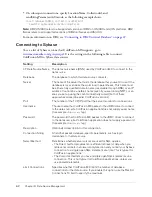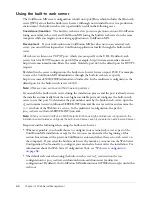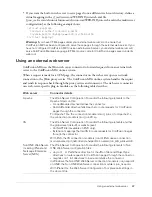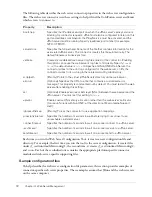
76
Chapter 4: Web Server Management
Apache
When you use Apache, you modify the
apache_root
/conf/httpd.conf file to create virtual hosts and
run the Web Server Configuration Tool. You store ColdFusion pages under the web root of each
virtual website.
To connect multiple Apache virtual hosts on a web server to a single ColdFusion server:
1.
Configure DNS for each virtual website, as described in your web server documentation.
2.
Open the
apache_root
/conf/httpd.conf file in a text editor and create virtual hosts, as necessary.
For more information, see your Apache documentation. For example:
...
NameVirtualHost 127.0.0.1
<VirtualHost 127.0.0.1>
ServerAdmin [email protected]
DocumentRoot "C:/Program Files/Apache Group/Apache2/htdocs"
ServerName SERVER02
ErrorLog logs/error.log
</VirtualHost>
<VirtualHost 127.0.0.1>
ServerAdmin [email protected]
DocumentRoot "C:/Program Files/Apache Group/Apache2/htdocs2"
ServerName mystore
ErrorLog logs/error-store.log
</VirtualHost>
<VirtualHost 127.0.0.1>
ServerAdmin [email protected]
DocumentRoot "C:/Program Files/Apache Group/Apache2/htdocs3"
ServerName myemployee
ErrorLog logs/error-employee.log
</VirtualHost>
...
3.
Test each virtual host to ensure that HTML pages are served correctly.
4.
Run the Web Server Configuration Tool, as follows:
■
GUI
Specify Apache for the Web Server, specify the directory that contains the httpd.conf
file, and select the Configure Web Server for ColdFusion MX Applications check box.
■
Command line
Specify
-ws
apache
and the directory that contains the httpd.conf file, as
the following example shows:
cf_root
/runtime/bin/wsconfig.exe -ws apache
-dir "c:\program files\apache group\apache2\conf"
-cfwebroot
cf_root
/wwwroot -coldfusion -v
For additional UNIX command-line examples, see
“Using the command-line interface”
on page 69
.
The Web Server Configuration Tool updates the httpd.conf file. For a sample, see
“Apache”
on page 76
.
5.
Restart Apache. You store ColdFusion files for each virtual host in the directory specified by the
DocumentRoot directive.
6.
Test each virtual host to ensure that ColdFusion pages are served correctly.
Summary of Contents for COLFUSION MX 7 - INSTALLING AND USING COLDFUSION...
Page 1: ...COLDFUSION MX7 Configuring and Administering ColdFusion MX ...
Page 6: ...6 Contents ...
Page 10: ......
Page 78: ...78 Chapter 4 Web Server Management ...
Page 84: ...84 Chapter 5 Deploying ColdFusion Applications ...
Page 102: ...102 Chapter 7 Using Multiple Server Instances ...
Page 104: ......
Page 108: ...108 Chapter 8 Introducing Verity and Verity Tools ...






























